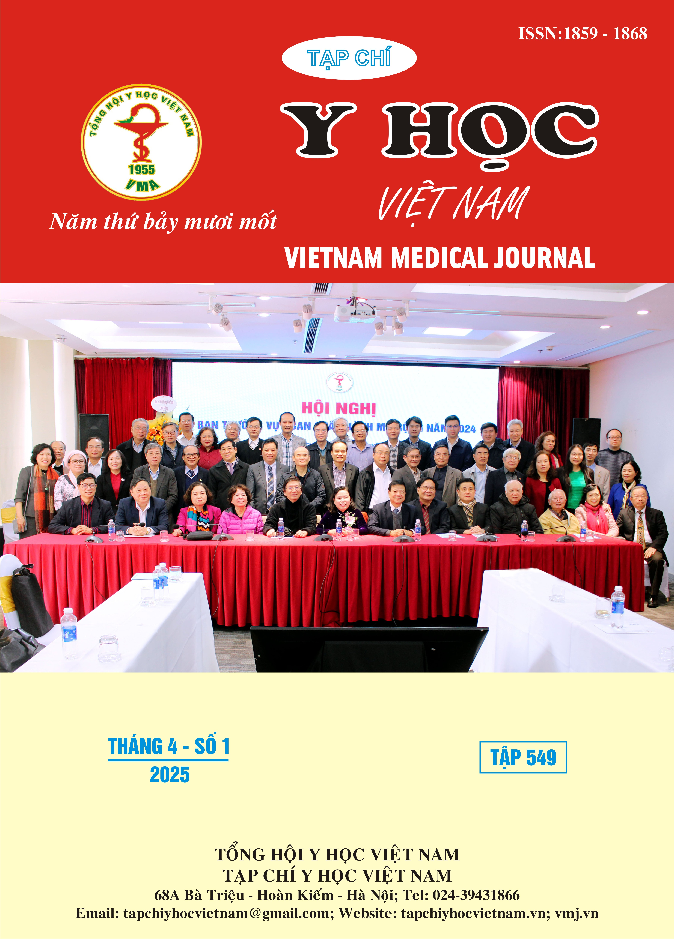PLASMA MATRIX METALLOPROTEINASE-2 CONCENTRATION AND TARGET ORGAN DAMAGE IN RESISTANT HYPERTENSION
Main Article Content
Abstract
Introduction: Resistant hypertension (RH) is a challenging condition in the management of hypertensive patients, associated with an increased risk of cardiovascular events, impaired renal function, and mortality. Matrix metalloproteinase-2 (MMP-2) plays a crucial role in extracellular matrix degradation, arterial stiffness, and target organ damage, yet research on RH patients remains limited. Methods: This was a cross-sectional study conducted on 131 hypertensive patients, including 67 RH patients and 51 non-RH patients. Clinical data, blood pressure, and biochemical parameters were collected. MMP-2 levels were measured using the ELISA method. Target organ damage was assessed through the urine albumin-to-creatinine ratio, estimated glomerular filtration rate (eGFR), left ventricular mass index (LVMI), ejection fraction, and pulse wave velocity (PWV). Statistical analyses included t-tests, Chi-square test, linear regression, and logistic regression. Results: The RH group had higher blood pressure, increased arterial stiffness, and more severe target organ damage (p < 0,05). MMP-2 showed a negative correlation with systolic blood pressure and pulse pressure in the non-RH group (p < 0,05). MMP-2 show correlation with ACR, PWV and eGFR (p < 0,05). Multivariate logistic regression confirmed MMP-2 as an independent predictor of RH (OR = 0,902; p = 0,021). Conclusion: RH group have a higher prevalance of target organ damage. Plasma MMP-2 is associated with target organ damage in hypertension patietn. The independent prognostic role of MMP-2 in resistant hypertension suggests that MMP-2 could be a potential biomarker for the detection and treatment of resistant hypertension.
Article Details
Keywords
Resistant hypertension, MMP-2, target organ damage, arterial stiffness, microalbuminuria
References
2. McEvoy, J.W., et al., 2024 ESC Guidelines for the management of elevated blood pressure and hypertension. Eur Heart J, 2024, 45(38): p. 3912-4018.
3. Muiesan, M.L., et al., Resistant hypertension and target organ damage. Hypertens Res, 2013, 36(6): p. 485-91.
4. Prado, A.F., et al., Matrix Metalloproteinases and Arterial Hypertension: Role of Oxidative Stress and Nitric Oxide in Vascular Functional and Structural Alterations. Biomolecules, 2021, 11(4).
5. Rizk, D.E.E., et al., Circulating matrix metalloproteinases and their tissue inhibitors as markers for ethnic variation in pelvic floor tissue integrity. Biomed Rep, 2018, 9(3): p. 233-240.
6. Van Minh, H., et al., Highlights of the 2022 Vietnamese Society of Hypertension guidelines for the diagnosis and treatment of arterial hypertension: The collaboration of the Vietnamese Society of Hypertension (VSH) task force with the contribution of the Vietnam National Heart Association (VNHA): The collaboration of the Vietnamese Society of Hypertension (VSH) task force with the contribution of the Vietnam National Heart Association (VNHA). J Clin Hypertens (Greenwich), 2022, 24(9): p. 1121-1138.
7. Wolosowicz, M., S. Prokopiuk, and T.W. Kaminski, The Complex Role of Matrix Metalloproteinase-2 (MMP-2) in Health and Disease. Int J Mol Sci, 2024, 25(24).
8. Yu, W., et al., Association of plasma MMP-2 levels and prognosis of patients with intracerebral hemorrhage: a prospective cohort study. Front Neurol, 2023, 14: p. 1259339.
9. Andrea R. Sabbatini, P., MSc, Increased Circulating Tissue Inhibitor of Metalloproteinase‐2 Is Associated With Resistant Hypertension. J Clin Hypertens (Greenwich). 2016 Oct; 18(10): 969–975,, 2016.
10. Givvimani S, K.S., Narayanan N, et al., TIMP-2 mutant decreases MMP-2 activity and augments pressure overload induced LV dysfunction and heart failure. . Arch Physiol Biochem. 2013;119:65–74,, 2013.


